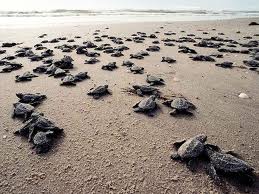Panama's Efforts to Protect the World's Sea Turtle Population

Panama's warm coastal waters and protected beaches offer good habitats for sea turtle nesting. Each year thousands of sea turtles make their way to various beaches along Panama’s coastline to lay precious eggs. The isthmus of Panama is home to 5 species of sea turtles: loggerhead, leatherback, hawksbill, green and olive ridley. Of the five mentioned species, four are on the critically endangered list. Sadly, scientific evidence shows sea turtle populations are dwindling. Scientists estimate that the hawksbill population has declined as much as 90% over the past 100 years. While turtles are faced with natural threats, such as crabs, birds and the occasional shark out at sea, It is human-caused threats that are pushing marine turtles towards extinction.
Each year turtles are caught in fishing nets, their eggs poached for food and their nests disrupted by domestic animals. Costal development has also had negative effects on sea turtle populations. Lights from urban developments can be disorienting and beach erosion from buldings make it difficult for females to find adequate nesting sites.
Females travel to the shores of Panama as early as June and continue to come sometimes well into January. It is said that females often return to the same beach they were born many years later to nest. Sea turtles lay 100 – 200 eggs per clutch, with an incubation time of approximately 45 – 50 days, depending on the species. The temperature of the nest will determine the sex of the hatchlings.
Hatching is a grueling process of digging, followed by a daunting journey to the water. Baby sea turtles spend their young life in floating about sub tropical water until they reach maturity. Only one in every thousand will reach full maturity.
In Panama several conservation efforts are working to restore the marine turtle population. Conservationists work to protect eggs and improve nesting conditions, with the hope of replenishing populations of sea turtles. Some of Panama's conservation projects are organized by Tortu-Agro, the Aquatic Resources Authority of Panama (ARAP) and the National Environmental Authority (ANAM).
La Marinera, Isla Cañas, Cambutal and Morrillo are home to the countries first sea turtle “Viveros” or nurseries. In April of this year over 11,000 Green and Olive Ridley hatchlings were born in Cambutal in artificial nurseries.
Anther organization called Tortuguías has also been working with the residents of Punta Chame to build the first sea turtle nursery in the playa community area. During the nesting season, Tortuguías organizes TORTUtrips to La Marinera starting in July. The trips are aimed towards monitoring turtles, cleaning up beaches, taking morphometric data, counting nests, and relocating nest to nurseries when needed. Another important efforts Tortuguías makes is to rase the awareness of sea turtles and the threats they face, in local communities. Tortuguías works with local schools, talking to children about recycling, the environment and conservation.
What you can do to help:
- Keep the beaches clean. Plastic is fatal to the digestive system of turtles. Floating plastic, which looks like jelly fish, which is the main source of food for turtles.
- Keep your dogs leashed when walking on nesting beaches, to prevent them from disturbing turtle nests.
- Educate friends, family and strangers on the importance on conserving the sea turtle population.
For more info on turtles, to join a conservation effort or to start a beach clean-up in an area near you contact Tortuguías by visiting www.tortuguias.org.
